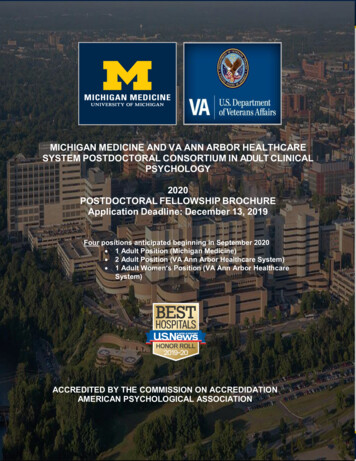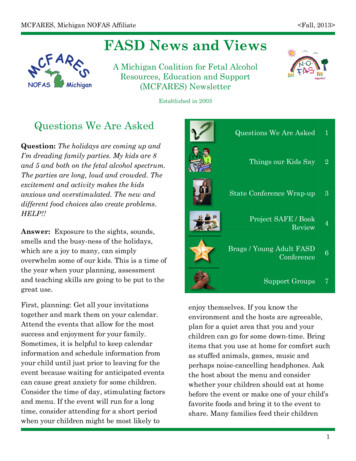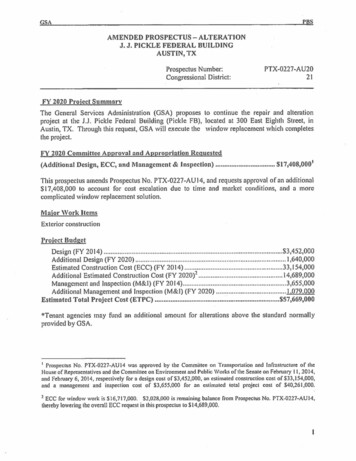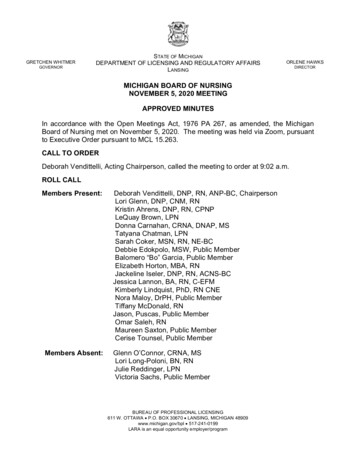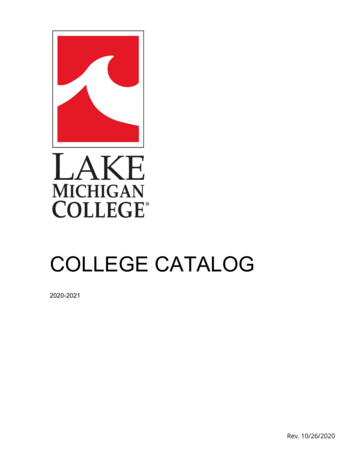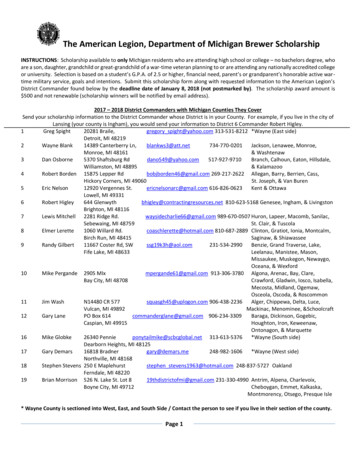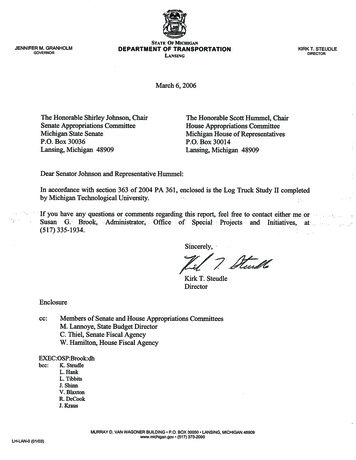
Transcription
Federal Project NumberMichigan Log Truck Study IIFINAL ReportNovember 2005Submitted byChristopher A. GreenKeweenaw Research CenterWilliam Sproule, Ph.D., P.E.Department of Civil & Environmental EngineeringTerance L. McNinchTim Colling, P.E.Diane BendaMichigan Tech Transportation InstituteMichigan Technological University1400 Townsend DriveHoughton, Michigan 49931
September 2005LOG TRUCK STUDY IIFINAL REPORTSubmitted byChristopher A. GreenKeweenaw Research Center/MTUWilliam Sproule, Ph.D., P.E.Terance McNinchTim Colling, P.E.Diane BendaMichigan Tech Transportation InstituteMichigan Technological UniversityHoughton, MI
DISCLAIMERThis document is disseminated under the sponsorship of the MichiganDepartment of Transportation (MDOT) in the interest of informationexchange. MDOT assumes no liability for its content or use thereof.The contents of this report reflect the views of the contracting organization,which is responsible for the accuracy of the information presented herein. Thecontents may not necessarily reflect the views of MDOT and do not constitutestandards, specifications, or regulations.
Log Truck Study II Final ReportEXECUTIVE SUMMARYMichigan’s timber industry has a significant impact on the State’s economy. Michigan log trucksmove about 250,000 loads of logs yearly. This translates into 23 million miles of loaded vehicletravel. Michigan’s log truck combinations are currently some of the largest vehicles on the roadstoday.This study continues the Michigan Log Truck Study that was done in 2003. The primary focusareas of this study are: Update the Literature Review done in 2003, Inventory theCharacteristics/Configurations of Log Trucks and Log Loads, Review Log Truck Crashes andSpills, and Recommend Practices and Innovations for Existing Documented Hazards.The Michigan log truck combination, consisting of a truck and trailer, fall into the LongCombination Vehicle (LCV) category. Michigan combination log trucks are currently limited byfederal law to a maximum of 70 feet. The federal restriction of overall vehicle length has slowedthe Michigan conversion to crib style trucks and trailers for log hauling. Recent requests toincrease the length of Michigan log truck/trailer combinations from 70 to 75 feet have beendenied at the federal level.This study monitored sites in the Upper Peninsula and the northern half of the Lower Peninsulato determine the size and characteristics of trucks hauling logs in Michigan. Log hauling vehiclesin Michigan come in a wide variety of configurations and sizes - there is no such thing as a“standard” log truck and trailer.With over 1,000 sightings, 885 log trucks were recorded on public roads. Of this total, 636 wereclearly identified for configuration and characteristics such as truck axles, trailer axles, selfloader, log load orientation, and securement method. The inventory identified 373 uniquevehicles. It is estimated that in 2005 there are at least 800 log trucks active in Michigan. Themajority (over 80%) of the log hauling vehicles in the U.P. are the 11 axle truck/pup trailercombinations with a self loader.The frequency of log trucks sighted ranged from one truck every 4 minutes at Sagola, to onetruck every 24 minutes at West Branch. Of the 338 trucks that were sighted loaded, 86% werecrosswise loaded. When the load securement method could be identified, the majority usedchains for tie-downs. Air binders were found to be well accepted (upwards of 90%) in the U.P.,but not as common in the Lower Peninsula.Auto tensioners evolved because of a need for a securement binder that would accommodate thesettling of a load of logs. This study found that air binders were used on the majority (90%) ofthe trailers operating in the U.P. Currently there are no standards or specifications for air binders.Task 5 of this report includes recommendations for good design practices.Michigan truckers have not readily adopted the crib style vehicle. A crib style vehicle carrieslogs lengthwise with lateral securement (bunks) and front and rear gates that prevent longitudinalshifting of the logs. Although crib style trailers offer an improvement in log hauling safety, theyare not being adopted for two reasons – load capacity and load securement. The biggest issuewith crib style rigs in Michigan is load capacity. For a self-loading truck and trailer crib design tocarry the same weight and volume of logs as is legal when crosswise loaded, a length exceedingthe current 70 foot federal limit is required. Requests by Michigan for an increase in overalllength at the federal level have been denied. Secondly, Michigan’s load securement lawrequiring two tie-downs per bundle is more restrictive than the FMCSA regulations. The timei
Log Truck Study II Final Reportrequired to attach and detach 12 tie-downs, compared to four tie-downs for a crosswise loadedvehicle, is a significant deterrent to the acceptance of crib hauling.Log truck crashes in the U.P. during 2001-2003 were compared with “all vehicle” crashes andthe “truck/bus” crashes for the same period. Within individual counties, the distribution patternsof log truck crashes follow the patterns of the all-vehicle crashes and the truck/bus crashes.Even when using extremely conservative estimates for the number of log trucks and vehiclemiles traveled for log trucks, the total crash and injury crash rates (crashes and injuries per 100Million VMT) for log trucks are significantly lower when compared to crash rates for all U.P.traffic, all State of Michigan traffic, and heavy truck traffic nationally. This indicates that logtrucks generally pose less of a crash and injury risk per vehicle mile traveled than the aggregatetraffic in the state, the U.P., and for heavy trucks nationally.Limited success was achieved in attempts to identify and contact log truck drivers who wereinvolved in log spill incidents. Because of the small sampling size, there is not enough data toallow conclusions to be drawn. However, the information gained from the interviews mayprovide some general insight into the nature of the spill problem. If further study of log spillincidents is a concern to policy makers, a better method for tracking log truck spill incidentswould be required.Conclusions Crosswise loaded pup trailers will continue to present a spill risk, but the hundreds ofthousands of loads that are hauled annually without incident indicate that this is anacceptable transportation method. Automatic tensioners are helpful for securing a load of logs, but they are not the solesolution for preventing log spills. Crib style vehicles, where lateral securement is built into the vehicle, are not beingreadily adopted in Michigan due to the reduced capacity and tie-down requirements. The distribution and patterns of log truck crashes are similar to that of all traffic in theU.P. and truck/bus traffic in the U.P. The crash rate for log trucks, crashes per 100 million miles traveled, is less than that forall traffic in the U.P., all traffic in Michigan, and all heavy truck/bus traffic in the U.S. Fatality and incapacitating injury rates are significantly lower than the rates for all U.P.traffic and equal to or less than the rate for all Michigan traffic. The insurance industry has been and will continue to be instrumental in getting high riskdrivers and vehicles off the road.Recommendations The Michigan timber industry should continue to educate log truck drivers on properloading and securement techniques. The Michigan State Police Motor Carrier Division should continue to offer Log TruckInspections on an annual basis. Mills are willing to support this effort. Michigan should consider adoption of the latest Federal Motor Carrier SafetyAdministration’s interpretation of tie-down requirements for crib style vehicles. Crib style vehicles should be encouraged. Automatic tensioners should be encouraged, especially on trailers.ii
Log Truck Study II Final Report Begin classifying log truck load loss as part of the crash reporting. Develop a better log truck crash reporting process. A feasibility study could be conducted to determine if smaller 7 or 8 axle truck trailercombinations are an economically viable option.iii
Log Truck Study II Final Reportiv
Log Truck Study II Final ReportTABLE OF CONTENTSTask 1 – Literature Review. 1Size, Weight and Securement Issues of Michigan Log Trucks 2005 Update. 1Truck Size and Weight Issues. 1Size and Weight Issues in Michigan. 2Load Securement Issues. 3Other Considerations . 3Task 2 – Inventory Characteristics/Configurations . 7Study Area . 7Proposed Monitoring Locations. 7Vehicle Configurations . 9Monitoring Site Results . 22Task 3 – Log Truck Crash Analysis . 29Methodology . 29Crashes in the U.P. 29Conclusions. 42Task 4 – Log Truck Spills Analysis. 45Discussion . 45Results. 46Conclusions. 48Task 5 – Best Practices and Recommendations. 49Automatic Tensioners . 49Air Binder Types. 49Air Binder Recommendations. 53Acceptable Securement Methods. 55Automatic Tensioner Design Standard . 58Crib Style Vehicles . 58Comments on the NMU Survey. 61Best Practices for Load Securement . 62Mixed Loads . 64Summary . 67State & Federal Truck Size and Weight Issues. 67Log Truck Inventory . 67Crash Analysis . 69Load Loss. 69Automatic Tensioners . 70Air Binder Recommendations. 71Acceptable Securement Methods. 73Crib Style Loading vs. Traditional Crosswise Loading. 73Other Alternatives. 74Conclusions. 74Recommendations. 75v
Log Truck Study II Final ReportAppendices.Crib Truck/Trailer Denial . 1Load Securement Ruling. 2Log Truck Inventory Form . 3Excel Files for PTR Sites. 4Michigan Vehicle Code . 5NMU Study. 6Logging Background . 7List of Sources . 8vi
Log Truck Study II Final Report – Task 1TASK 1 – LITERATURE REVIEWSize, Weight and Securement Issues of Michigan Log Trucks 2005UpdateThis literature review identifies developments affecting the log hauling industry in Michigansince the Michigan Log Truck Study – Final Report that was published in February 2003.Truck Size and Weight IssuesLong Combination Vehicles (LCVs) are normally considered a tractor with either two or threetrailers. The Michigan log truck combination, consisting of a truck and trailer, also falls into thiscategory. Michigan log truck combinations are currently limited to a maximum of 70 feet for thetruck and trailer. Changes in maximum overall vehicle length require a federal “Act ofCongress” and are not left to state jurisdiction.The Intermodal Surface Transportation Efficiency Act (ISTEA) of 1991 froze the allowablelength, weight and routes of LCVs. Recent requests to increase the length of Michigan logtruck/trailer combinations from 70 to 75 feet have been denied at the federal level. Michigan’slogging interests had hoped that the length issue would be addressed in the reauthorization ofTEA-21.Prior to considering the reauthorization of TEA-21, Congress requested a study on truck size andweight issues. The Transportation Research Board (TRB) issued Special Report (SR-267) inMay 2004. The report’s recommendations included significant reforms in how truckingregulations should be developed – logical engineering/scientific basis versus political agendas.None of the SR-267 recommendations were included in the reauthorization of TEA21SAFETEA-LU.While TEA-21 reauthorization was being considered, additional legislation was introduced tofurther restrict longer vehicles. The Safe Highways and Infrastructure Protection Act, SHIPA –Senate Resolution S-95, (was S-1445 during the 108th Congress) intended to extend the currentrestriction of LCVs for the 44,000 mile Interstate Highway System to the 156,000 mile NationalHighway System (NHS). In addition, the length restriction would apply to all new NHS routesand existing routes where capacity is increased. On January 24, 2005, the resolution was referredto the Senate Environment and Public Works Committee where it awaits action.During TEA-21 reauthorization, the Association of American Railroads (AAR) and theAmerican Trucking Association (ATA), two major stakeholders in the transportation act becauseof freight movement, signed an agreement to not contest trucking size and weight issues. TheAAR has fought for a decrease in truck size and weight on the basis that the trucking industry isnot paying its fair share for road use. The ATA, which represents such major trucking interests asUnited Parcel Services, FedEx Freight, Roadway Express and Yellow Transportation, agreed tonot lobby for increased capacity changes, even though some of their members would benefitfrom increased capacity. The ATA/AAR agreement was based on the fact that there were othermore critical issues for the trucking industry that needed to be addressed before the truck sizeand weight issue.It is unlikely that the federal restriction on overall vehicle length of 70 feet, and hence the 75 footcrib-style vehicle, will be considered until the reauthorization of SAFETEA-LU.1
Log Truck Study II Final Report – Task 1Size and Weight Issues in MichiganThe move to increase the overall length of Michigan logging trucks to 75 feet was initiallyproposed in November 2002 as House Bill 6486 (2002), but this died in the Senate in December2002. The proposal re-emerged in House Bill 4154 (2003) which was introduced in February2003 and was eventually passed and approved by the Governor on July 31, 2003, as Public Act142 of 2003, effective August 5, 2003.The increased length allowance in this legislation was in conflict with federal length restrictions.If enacted, Michigan would be subjected to federal sanctions that could amount to 10% or up to 90 million dollars of its federal transportation funds. The final bill was modified to include astatement that the length increase would not become effective until Section 127(d) of Title 23 ofthe United States Code, 23USC 127, was amended to allow 75 foot long crib-style log vehicles.In March 2004, the Michigan House of Representatives tried once again to push Congress to acton the 75 foot crib-style log trucks by adopting House Resolution 0168 (2003). The resolution'sintent was to get Congress and the United States Department of Transportation to permit the useof 75 foot crib carrier log hauling equipment during the Surface Transportation Reauthorization.In 2004, Michigan did, however, make the following size changes that did not conflict withfederal restrictions: Maximum trailer width was increased from 96 to 102 inches for all roads under Section257.717 of Act 511 of 2004. Previously 102 inch wide trailers were only allowed ondesignated highways. The 65 foot maximum length limit was extended to other combination ve
increase the length of Michigan log truck/trailer combinations from 70 to 75 feet have been denied at the federal level. This study monitored sites in the Upper Peninsula and the northern half of the Lower Peninsula to determine the size and characteris

